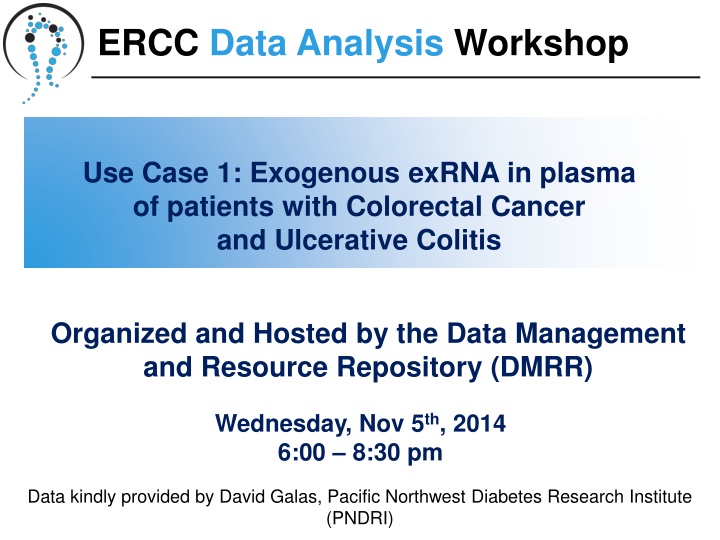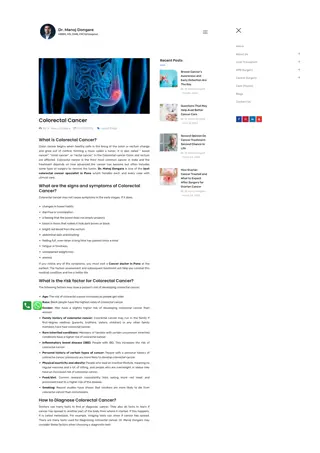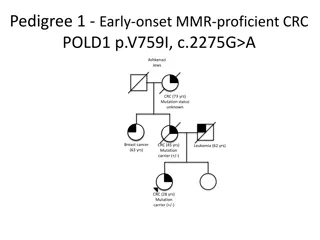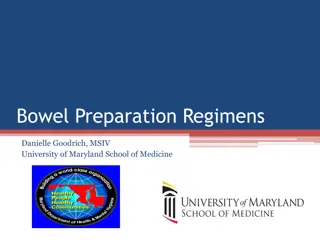Exogenous exRNA in Colorectal Cancer and Ulcerative Colitis
Workshop focusing on exogenous exRNA in plasma of patients with Colorectal Cancer and Ulcerative Colitis, analyzing small RNA profiles, mapping reads not mapping to the human genome, and investigating sources of small RNAs. Data provided by David Galas, PNDRI. Utilizing the Genboree Workbench for analysis and answering key questions related to miRNAs and RNA spectra.
Download Presentation

Please find below an Image/Link to download the presentation.
The content on the website is provided AS IS for your information and personal use only. It may not be sold, licensed, or shared on other websites without obtaining consent from the author.If you encounter any issues during the download, it is possible that the publisher has removed the file from their server.
You are allowed to download the files provided on this website for personal or commercial use, subject to the condition that they are used lawfully. All files are the property of their respective owners.
The content on the website is provided AS IS for your information and personal use only. It may not be sold, licensed, or shared on other websites without obtaining consent from the author.
E N D
Presentation Transcript
ERCC Data Analysis Workshop Use Case 1: Exogenous exRNA in plasma of patients with Colorectal Cancer and Ulcerative Colitis Organized and Hosted by the Data Management and Resource Repository (DMRR) Wednesday, Nov 5th, 2014 6:00 8:30 pm Data kindly provided by David Galas, Pacific Northwest Diabetes Research Institute (PNDRI)
Use Case 1: Exogenous exRNA Background: Comparison of human plasma small RNA profiles of patients with colorectal cancer to those with ulcerative colitis, indicated that a large fraction of reads were not mapping to the human genome. This raised the question as to what was the origin of those small RNAs? Results: Mapping suggested that a significant fraction of small RNA reads were derived from bacterial, fungal, and plant sources. Wang K., Hong L., Yuan Y., Etheridge A., Zhou Y., Huang D., Wilmes P., & Galas D. (2012) The Complex Exogenous RNA Spectra in Human Plasma: An Interface with Human Gut Biota? PLoS ONE 7: e51009. 2
Use Case 1: Exogenous exRNA We will use the Genboree Workbench to check what fraction of reads do not map to the human genome. We will also use the output of the small RNA-seq Pipeline to answer the following questions: Do all plasma small RNAs map to the human genome (slide 17)? Which miRNAs are normally present in human plasma (slide 18)? What are the sources of small RNAs found in human plasma that do not map to the human genome (exercise)? Wang K., Hong L., Yuan Y., Etheridge A., Zhou Y., Huang D., Wilmes P., & Galas D. (2012) The Complex Exogenous RNA Spectra in Human Plasma: An Interface with Human Gut Biota? PLoS ONE 7: e51009. 3
Use Case 1: Exogenous exRNA Biological Samples to Be Analyzed Patient Number Sample Input File Name Biosample Metadata # in KB SM1_crc1_sequence.fastq.gz #1 Plasma (Colorectal) EXR-022273PF-BS SM2_crc2_sequence.fastq.gz #2 Plasma (Colorectal) EXR-022163PF-BS SM3_crc3_sequence.fastq.gz #3 Plasma (Colorectal) EXR-022299PM-BS SM6_uc1_sequence.fastq.gz #4 Plasma (Ulcerative) EXR-93163PMC-BS SM7_uc2_sequence.fastq.gz #5 Plasma (Ulcerative) EXR-93164PMC-BS SM8_uc3_sequence.fastq.gz #6 Plasma (Ulcerative) EXR-93166PFC-BS SM11_norm1_sequence.fastq.gz #7 Plasma (Control) EXR-D3340PMN-BS SM12_norm2_sequence.fastq.gz #8 Plasma (Control) EXR-D3176PFN-BS SM3_norm3 _sequence.fastq.gz #9 Plasma (Control) EXR-D3142PFN-BS Input files are located in the Data Selector in the following Group Group: exRNA Metadata Standards Database: Use Case 1: Exogenous exRNA in Colorectal Cancer and Ulcerative Colitis Folder: 1. Inputs (FASTQ) Database Folder: 4
Genboree Workbench Getting Started Getting Started http://genboree.org/theCommons/projects/pub lic-commons/wiki/Getting_started Genboree Workbench Icons Explanation http://genboree.org/theCommons/projects/pub lic-commons/wiki/genboree_icons FAQs http://genboree.org/theCommons/ezfaq/index/ public-commons 5
Genboree Workbench Create Database Create a Genboree Workbench Database http://genboree.org/theCommons/ezfaq/show/ public-commons?faq_id=491 hg19 Note: - You will be using this newly created Genboree Workbench Database to hold the output of tool runs. This will be the database that we re referring to when we say your database . 6
Running the Pipeline: Select Input Files Note: You will input (1) fastq file per tool run. So, for each fastq file you wish to analyze, you will need to repeat the process shown on the next 3 slides. 7
Running the Pipeline: Select Output Database Note: Drag Your newly created database to Output Targets. 8
Post-processing: Select Input Files Note: These zip files will be in your database, in the folder that you named: Files/smallRNAseqPipeline/[your analysis name]/ 11
Post-processing: Select Output Database Note: Drag Your newly created database to Output Targets. 12
Post-processing: Begin Analysis (Excel) Note: The processed files to the left will be in your database, but will be in the folder that you named: Files/processPipelineRuns/ [your analysis name]/ 15
Use Case 1: Pipeline Results - Number of Input Reads Wang et al (2012) Case 3) Summary Table from small RNAseq Pipeline miRNA plantVirus sense 12,323 9,776 8,048 3,266 4,076 1,817 2,915 4,510 5,218 Sample ID calibrato r miRNA sense 156,670 72,638 91,661 47,204 55,287 13,768 21,834 21,307 155,573 miRNA antisense tRNA sense 12 12 15 8 10 4 6 4 8 tRNA antisense piRNA sense piRNA antisense snoRNA sense snoRNA antisense Rfam sense Rfam antisense input 27,002,901 10,349,566NA 27,957,185 28,214,261 21,132,674 23,547,368 22,729,858 20,626,993 18,186,259 28,426,819 clipped rRNA 3,483,706 3,253,551 2,929,074 1,508,605 1,901,356 704,887 1,714,180 1,937,719 2,447,302 not_rRNA 6,865,860 3,154,174 6,619,396 2,969,730 6,387,453 2,901,247 2,946,957 1,307,657 3,836,332 1,721,248 1,726,815 3,550,880 1,553,158 3,804,303 1,642,329 4,647,784 2,099,770 genome norm1 norm2 norm3 crc2 crc3 crc1 uc1 uc2 uc3 14,751 11,756 12,492 5,494 7,950 1,779 11,400 7,066 10,296 44 51 38 18 18 730 609 732 504 667 243 662 666 720 162 264 197 198 171 62 229 148 239 111 118 130 85 77 24 184 58 133 22 0 0 0 0 0 0 0 0 0 0 0 0 0 0 0 0 0 0 9,872,947NA 9,316,527NA 4,455,562NA 5,737,688NA 2,431,702NA 5,265,060NA 5,742,022NA 7,095,086NA 176 23 168 282 767,523 6 4 25 17 33 180 168 171 16
Use Case 1: Pipeline Results - Do all plasma small RNAs map to the human genome? Wang et al (2012) Summary Table from small RNA-Seq Pipeline Sample Mapped Fraction 46% 45% 45% 44% 45% 44% 44% 43% 45% Unmapped Fraction 54% 55% 55% 56% 55% 56% 56% 57% 55% not_rRNA genome norm1 norm2 norm3 crc2 crc3 crc1 uc1 uc2 uc3 6865860 6619396 6387453 2946957 3836332 1726815 3550880 3804303 4647784 3154174 2969730 2901247 1307657 1721248 767523 1553158 1642329 2099770 Fraction mapping to the human genome = genome / not_rRNA 17
Use Case 1: Pipeline Results Reads Mapping to miRNA Wang et al (2012) Fraction of reads mapping to miRNA = miRNA_sense / not_rRNA Summary Table from Pipeline miRNA plantVirus sense 0.1795% 0.1477% 0.1260% 0.1108% 0.1062% 0.1052% 0.0821% 0.1185% 0.1123% miRNA sense average 1.60% not rRNA 100% 100% 100% 100% 100% 100% 100% 100% 100% miRNA sense 2.28% 1.10% 0.0002% 1.44% 1.60% 1.44% 0.80% 0.61% 0.56% 3.35% miRNA antisense tRNA sense 0.0002% tRNA antisense piRNA sense piRNA antisense 0.0024% 0.0040% 0.0031% 0.0067% 0.0045% 0.0036% 0.0064% 0.0039% 0.0051% snoRNA sense 0.0016% 0.0018% 0.0020% 0.0029% 0.0020% 0.0014% 0.0052% 0.0015% 0.0029% snoRNA antisense 0.0003% 0.0027% 0.0004% 0.0057% 0.0074% 0.0002% 0.0051% 0.0044% 0.0037% sample input norm1 norm2 norm3 crc2 crc3 crc1 uc1 uc2 uc3 clipped rRNA 151% 149% 146% 151% 150% 141% 148% 151% 153% genome 393% 422% 442% 717% 614% 1316% 581% 478% 612% 51% 49% 46% 51% 50% 41% 48% 51% 53% 46% 45% 45% 44% 45% 44% 44% 43% 45% 0.2148% 0.0006% 0.0106% 0.1776% 0.0008% 0.0092% 0.1956% 0.0006% 0.0115% 0.1864% 0.0006% 0.0171% 0.2072% 0.0005% 0.0174% 0.1030% 0.0003% 0.0141% 0.3210% 0.0007% 0.0186% 0.1857% 0.0004% 0.0175% 0.2215% 0.0007% 0.0155% 0.0002% 0.0003% 0.0003% 0.0002% 0.0002% 0.0001% 0.0002% 1.28% 1.51% 18
Use Case 1: Which miRNAs are normally present in human plasma? We can look for the answer to this question in the processed pipeline output file DG_miRNA_Quantifications_RPM.txt. Diff. Expr. Average s miRNA hsa-let-7b-5p hsa-miR-451a hsa-let-7a-5p hsa-miR-378a-3p hsa-miR-143-3p hsa-let-7f-5p hsa-miR-486-5p hsa-miR-1 hsa-miR-184 hsa-miR-1246 hsa-miR-423-5p hsa-miR-24-3p hsa-miR-3168 hsa-miR-146a-5p hsa-miR-21-5p hsa-miR-140-3p hsa-miR-122-5p hsa-miR-148a-3p hsa-let-7g-5p norm1 norm2 norm3 crc1 1984.6 1502.2 1442.2 864.2 996.1 2765.0 1610.3 2740.2 3287.0 1553.6 871.3 1151.9 904.5 1330.3 938.4 1471.7 714.1 935.4 1326.8 1050.5 1547.2 490.0 765.8 1047.0 612.5 708.8 2071.1 22.1 31.9 1864.8 11.1 14.0 854.3 296.5 226.1 817.4 242.4 141.6 1147.0 531.6 279.3 318.8 318.9 324.2 276.6 418.8 220.8 257.8 304.1 210.8 372.5 260.4 242.1 381.3 480.7 83.7 301.6 445.7 112.6 287.9 374.1 183.9 221.1 crc2 crc3 uc1 uc2 uc3 norm crc uc crc/norm uc/norm 0.7494 1.6512 0.6419 0.7745 0.9245 0.5922 0.9937 0.0349 0.0193 0.3982 1.4525 0.6900 1.1176 0.5755 0.7507 1.1449 0.4799 0.7268 0.5964 363.6 1670.5 1659.6 614.0 994.1 410.7 162.4 198.5 215.3 246.2 332.7 134.9 369.7 52.9 122.3 527.2 82.3 162.7 117.7 62.1 71.2 78.9 674.8 4728.0 1643.0 1231.2 2005.6 294.3 8648.2 1541.8 2545.8 3312.2 341.2 2000.5 1192.3 286.5 865.1 1057.8 101.8 179.7 1040.4 262.0 1125.8 934.3 207.6 4135.3 789.4 202.0 73.4 708.4 22.6 13.8 630.0 221.2 577.3 458.9 115.8 715.2 400.5 158.7 190.9 376.5 299.1 592.4 306.6 133.9 160.4 299.1 195.6 477.3 295.8 67.5 1215.9 294.6 457.0 768.4 288.7 149.0 283.2 282.1 84.8 284.3 259.7 1.2207 2.1483 0.7695 0.4141 0.1538 0.5719 1.9376 0.2861 0.0906 0.8485 0.7357 0.4178 1.5424 0.4196 0.9416 1.5853 1.4865 0.5948 0.5750 320.2 516.2 1462.7 906.2 1069.6 765.3 819.2 961.8 553.3 784.4 1529.7 24.7 12.2 182.8 581.7 259.8 342.7 172.1 222.0 337.3 138.5 205.0 154.9 917.5 438.0 160.0 534.3 478.7 508.2 517.3 602.3 472.8 14.2 21.0 306.6 540.2 634.5 1246.0 25.5 7.8 161.7 323.5 356.8 626.0 250.0 313.2 417.8 285.2 304.0 212.1 34.5 7.7 80.0 274.6 291.7 390.4 231.1 268.8 379.7 116.9 238.5 209.8 202.7 57.1 389.4 294.6 157.3 472.9 125.5 278.5 467.0 429.1 167.8 149.3 130.9 11.5 35.3 84.1 214.3 13.6 72.6 42.7 We added columns for averages and differential expression, and then sorted by the average expression level in normal plasma. 19
Use Case 1: Summary 55-60% of miRNA reads do not map to the human genome. ~1.5% of reads map to human miRNA. A fraction of a percent of reads map to plant or viral miRNA. 20























